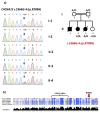Dihydropyridine Receptor Congenital Myopathy In A Consangineous Turkish Family
- PMID: 31227654
- PMCID: PMC6736676
- DOI: 10.3233/JND-190383
Dihydropyridine Receptor Congenital Myopathy In A Consangineous Turkish Family
Abstract
Dihydropyridine receptor congenital myopathy is a recently described congenital myopathy caused by dominant or recessive mutations in the CACNA1S gene. To date, only 11 cases from 7 families were described in a single report. Here, we describe a consanguineous family with three affected children, presenting congenital hypotonia, contractures, ophthalmoplegia and respiratory insufficiency, with a novel homozygous mutation in the CACNA1S gene. They also showed cognitive delay, pes equinovarus deformity and neurogenic changes that have not been associated with this myopathy in the previous reports. This report expands the phenotypic spectrum of dihydropyridine receptor congenital myopathy and underscores the importance of whole exome sequencing in early onset neuromuscular disorders.
Conflict of interest statement
The authors declare that they have no conflict of interest.
Figures




Similar articles
-
Dihydropyridine receptor (DHPR, CACNA1S) congenital myopathy.Acta Neuropathol. 2017 Apr;133(4):517-533. doi: 10.1007/s00401-016-1656-8. Epub 2016 Dec 23. Acta Neuropathol. 2017. PMID: 28012042
-
Phenotypic Variability of MEGF10 Variants Causing Congenital Myopathy: Report of Two Unrelated Patients from a Highly Consanguineous Population.Genes (Basel). 2021 Nov 10;12(11):1783. doi: 10.3390/genes12111783. Genes (Basel). 2021. PMID: 34828389 Free PMC article.
-
Expanding the spectrum of congenital myopathy linked to recessive mutations in SCN4A.Neurology. 2017 Jan 24;88(4):414-416. doi: 10.1212/WNL.0000000000003535. Epub 2016 Dec 21. Neurology. 2017. PMID: 28003497 Free PMC article. No abstract available.
-
Phenotypic variability in myotonia congenita.Muscle Nerve. 2005 Jul;32(1):19-34. doi: 10.1002/mus.20295. Muscle Nerve. 2005. PMID: 15786415 Review.
-
Congenital myotonia: a review of twenty cases and a new splice-site mutation in the CLCN1 gene.Turk J Pediatr. 2020;62(3):450-460. doi: 10.24953/turkjped.2020.03.012. Turk J Pediatr. 2020. PMID: 32558419 Review.
Cited by
-
Core myopathy in two siblings with a biallelic variant in the CACNA1S gene-A case series study.Clin Case Rep. 2024 Aug 5;12(8):e9251. doi: 10.1002/ccr3.9251. eCollection 2024 Aug. Clin Case Rep. 2024. PMID: 39104734 Free PMC article.
-
Update on Congenital Myopathies in Adulthood.Int J Mol Sci. 2020 May 24;21(10):3694. doi: 10.3390/ijms21103694. Int J Mol Sci. 2020. PMID: 32456280 Free PMC article. Review.
-
Case report: Dihydropyridine receptor (CACNA1S) congenital myopathy, a novel phenotype with early onset periodic paralysis.Front Neurol. 2024 Feb 15;15:1359479. doi: 10.3389/fneur.2024.1359479. eCollection 2024. Front Neurol. 2024. PMID: 38426167 Free PMC article.
-
Congenital Myopathy as a Phenotypic Expression of CACNA1S Gene Mutation: Case Report and Systematic Review of the Literature.Genes (Basel). 2023 Jun 28;14(7):1363. doi: 10.3390/genes14071363. Genes (Basel). 2023. PMID: 37510268 Free PMC article.
-
Targeted Therapies for Skeletal Muscle Ion Channelopathies: Systematic Review and Steps Towards Precision Medicine.J Neuromuscul Dis. 2021;8(3):357-381. doi: 10.3233/JND-200582. J Neuromuscul Dis. 2021. PMID: 33325393 Free PMC article.
References
-
- Rebbeck RT, Karunasekara Y, Board PG, Beard NA, Casarotto MG, Dulhunty AF. Skeletal muscle excitation–contraction coupling: Who are the dancing partners? Int J Biochem Cell Biol. 2014;48:28–38. - PubMed
-
- Jurkat-Rott K, Lehmann-Horn F, Elbaz A, Heine R, Gregg RG, Hogan K, Powers PA, Lapie P, Vale-Santos JE, Weissenbach J, et al. A calcium channel mutation causing hypokalemic periodic paralysis. Hum Mol Genet. 1994;3:1415–9. - PubMed
-
- Kung AW, Lau KS, Fong GC, Chan V. Association of novel single nucleotide polymorphisms in the calcium channel alpha 1 subunit gene (Ca(v)1.1) and thyrotoxic periodic paralysis. J Clin Endocrinol Metab. 2004;89:1340–5. - PubMed
MeSH terms
Substances
Grants and funding
LinkOut - more resources
Full Text Sources
Molecular Biology Databases

